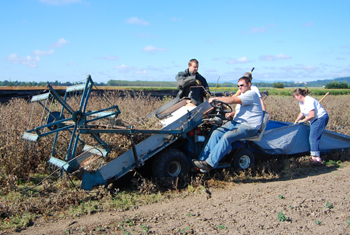Corvallis Plant Materials Center (ORPMC)
Serving areas in the States of California, Oregon, and Washington
Established: 1957
Size: 58 acres
PMC Operation: NRCS
Land Ownership: Oregon State University
 The Corvallis Plant Materials Center (ORPMC) provides plant solutions for northwestern California, western Oregon, and western Washington. The Center’s service area includes the northern Pacific Coast Range, Willamette Valley and Puget Sound, as well as Olympic, Cascade, and Siskiyou Mountains of western Washington and Oregon. Heavily forested coastal terraces, steep mountains, grass balds, foothills, valleys, flood plains, woodland prairies, and Savanna vegetation in the Willamette valley and Puget lowlands typify the topography and natural vegetation.
The Corvallis Plant Materials Center (ORPMC) provides plant solutions for northwestern California, western Oregon, and western Washington. The Center’s service area includes the northern Pacific Coast Range, Willamette Valley and Puget Sound, as well as Olympic, Cascade, and Siskiyou Mountains of western Washington and Oregon. Heavily forested coastal terraces, steep mountains, grass balds, foothills, valleys, flood plains, woodland prairies, and Savanna vegetation in the Willamette valley and Puget lowlands typify the topography and natural vegetation.
Wind and water erosion are critical problems on coastal dunes, roadsides, construction sites, dredge spoils, cultivated cropland, and logging areas. Water quality is a main concern in areas of concentrated livestock, farming, and urban activities. Degraded fish habitat, streambanks, and wetlands are in need of enhancement and restoration.
The Corvallis Plant Materials Center’s primary mission is to develop new technology in plant propagation and establishment, seed production, revegetation, restoration, and erosion control, and to develop new plant sources for use in riparian areas, wetlands, and uplands.
Highlights
DECLINING DIVERSE PLANT AND WILDLIFE HABITAT
Enhancing native species diversity
- Encourage production of native plants by conducting studies on propagation, production and establishment of plants.
- Promote establishing, maintaining, and enhancing habitat for native pollinators through development of technical publications such as Plants for Pollinators in Oregon.
- Work with private industry to develop sources of native plants for plant community restoration activities using ORPMC developed plants.
RESTORE AND SUSTAIN HEALTHY NATURAL ECOSYSTEMS
Develop sources of appropriate native plants for restoration activities
- Wetland, riparian, and upland habitat in the Pacific Northwest is enhanced through selection of 16 native trees, shrubs, and grasses.
- Identify seed transfer zones for native plants using genecological approaches in cooperative studies with partners.
- Provide technical information on the adaptation, establishment, commercial availability, and use of native plants through the development of numerous Plant Fact Sheets.
CONSERVATION OF RARE, SENSITIVE, THREATENED OR ENDANGERED PLANTS
Develop plant technologies for various native plant species
- Encourage commercial availability of native plants through development and publication of propagation protocols.
- Increase public knowledge of threatened and endangered species (T&E) by maintaining plantings of T&E species at the Center to serve as training and identification tools.
- Improve success of plantings through publication of Ability of Pacific Northwest Shrubs to Root from Hardwood Cuttings (with Summary of Propagation Methods for 22 Species) developed to provided detailed information on the establishment of cuttings for restoration.
Corvallis Plant Materials Center
3415 NE Granger Ave.
Corvallis, OR 97330-9620
Telephone: 541-757-4812
Fax: 855-651-9082